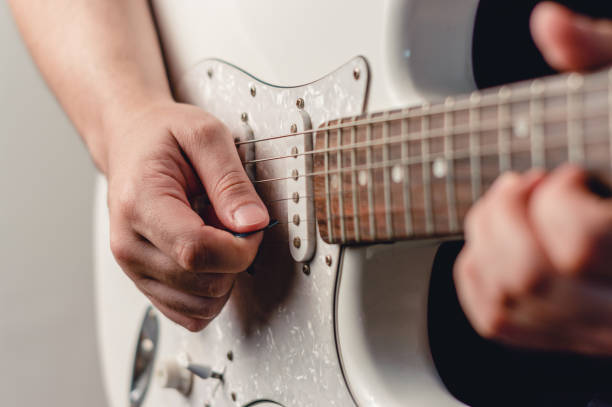
How to Hold a Guitar Pick
Learning the guitar is a process of exploration, and one of the first aspects of that exploration is how to hold a guitar pick properly. Whether you are very new to playing guitar or have been through it for several years, getting your pick grip right would go a long way to building your sound and persona. Here, you will learn basic principles of how to hold a guitar pick, or ‘grip’ as well as more detailed methods to further enhance your skills on the instrument.
The Proper Technique in the Process of Picking
Now that we know a little about how to hold a guitar pick, perhaps we should step back and see why it is so critical. The position or style in which you hold your pick determines your tonal quality, pacing, precision, and comfort while playing. A good pick grip enables you to pick the strings in the right manner, control the dynamics of the sound you want to produce, and even manage to play complicated pieces of work on the guitar. However, poor grip results in poor control of the drum and hence produces low sound quality; the musician gets tired and at long last may have to incur the wrath of music from his or her hand.

This paper aims to establish some of the essential modes of holding a guitar pick.
The Standard Grip
The easiest method of how to hold a guitar pick is by the standard grip. Here’s how to do it:
- This involves holding the pick between your thumb and the forefinger.
- Hold the pick where it plectrums between 1/4 and 1/3 of the total length of the pick.
- Tilt your wrist slightly, and do not clench your hand around the handle.
- Tilt the pick slightly towards the strings to make your playing a bit easier.
This grip affords sufficient control and suppleness that is suitable for most styles of playing.
The Pinch Grip
Another popular technique for how to hold a guitar pick is the pinch grip.
- But how does one wield this mighty tool? You want to pinch the pick with your thumb and index finger as you hold the tool like a pen between the pads of your thumb and index finger.
- Flex your other fingers into a loose fist to the inside portion of the palm.
- It is better to use a smaller portion of the pick’s tip so you can have better control of it.
The pinch grip provides a great deal of control for speed and precision; it is the most preferred by most lead guitarists.
There are so many holding methods by picking that ensure our clients benefit from their crops more than any other holding technique.
During this guitar learning process, you may wish to learn other complex methods that are involved with how to hold a guitar pick. Here are a couple of techniques to consider:
The Three-Finger Grip
This method involves using three fingers to hold the pick:
- As for the choice of a pick, hold it with three fingers: the thumb, the index finger, and the one in the middle.
- For more stability and control, you ought to use the extra finger.
- Try another position with your fingers to learn which one is best for them.
The Floating Grip
For a lighter touch and faster playing, try the floating grip:
- When holding the pick, try to do it with just the thumb and the forefinger, and make sure its grip is not too tight.
- It is all right for the pick to sit lightly on the strings and not grip it too firmly.
- I suggest that one should apply wrist and arm motion to influence the pick’s motion.
How to Hold the Racket Depending on the Match Engagements
Developing how to hold a guitar pick is not about looking for one way or technique; it is about adjusting the grip to correspond to certain playing styles or techniques. Here’s how to adjust your grip for various scenarios:
Strumming
If you are strumming chords, then it will be highly beneficial to have a less tightened grip on the pick, as this will generate more sound. Let the pick run over the strings more freely so it will cause less friction.
Lead Playing
When it comes to setting up the specific characteristics of the lead lines or soloing, perhaps a better grasp of the pick is exactly what’s required. Try the different angles of holding the pick to get the best for your style of drumming.
Alternate Picking
While practicing the muscles behind your right-hand fingers, which are used when practicing your alternate picking method, observe that there are two points of contact with the string—the pick and the picks. Needless to say, the grip and angle of the pick should be as consistent as possible during the string travels.
Common Mistakes to Avoid
As you practice how to hold a guitar pick, be aware of these common pitfalls:
- Gripping too tightly: This can cause tension and fatigue as conflicting ideas run in parallel with one another.
- Holding the pick at the wrong angle: A wrong angle will have the pick hitting against the strings.
- Using too much of the pick: Prying too far of the pick’s tip leads to the inability to control the interactions.
- Ignoring pick thickness: Picking with thin picks demands just a little bit more grip and changes in pick attack to that when using mediums.
Choosing the Right Pick
Depending on the type of pick you prefer, the way it is held is also essential to pay attention to. If you are learning how to hold a guitar pick, you should not shy away from trying various types of picks, their sizes, and their thickness. There are the players who use a very thin and flexible pick for strumming and the others who use the thick pick for lead.
Activity Drills for Enhancing Your Pick Grip
To master how to hold a guitar pick, try these exercises:
- Pick-hand isolation: Try holding the pick and making the movements with your hand if the guitar is not in your hand to establish muscular memory.
- Single-string exercises: Concavity should be focused on choosing one string with the correct tone and volume throughout its length.
- String skipping: Practice shifting the pick across a spread to increase the accuracy of play.
- Speed building: It is advised that one gradually increases the speed of picking as the success rate of form accuracy greatly decreases the faster that one is picking.
The Role of Relaxation
A major criterion on how any form of learning how to hold a guitar pick has to be managed is by ensuring that the grip is loose. Stress is the major killer of good form; remember to maintain the relaxation of your hand, wrist, and arm as play. This will also prevent you from straining your vocal folds and causing yourself other injuries or keeping you fatigued beyond being able to sing well.
Carrying out these changes over some time.
Bear in mind that your stance regarding a guitar pick might change over time while you are developing as a musician. Experiment with the grips and be flexible with your approach as your progress through the bands comes from giving yourself the leeway to work something new into your game.

Conclusion
Sustainability is a very important element of performance, and dealing with this can be very beneficial for one’s playing. While reading this article, you will get brief information about pick grip and different ways to perform it, and if you practice these regularly, your pick grip will be lethal and friendly with your fingers. However, try to recall that there isn’t any perfect way to pick up the guitar pick; what matters is simply choosing a technique that feels most comfortable to hold your pick while playing.
FAQs
Many beginner guitarists ask how long it takes to feel natural while picking the guitar with a pick.
It may take some people a few minutes to feel right in holding a guitar pick. Quick learners may take less than a week to say that they are comfortable while playing the game, while others may take about three weeks to get the best grip that is comfortable for them. Most of the work involves repetition; the driver and the pick must learn to be comfortable with the idea of holding the pick, and practicing should take plenty of time.
Is it possible to play a guitar without a pick?
Absolutely! Be that as it is, it is common knowledge that many guitarists use their fingers or nails to pluck or strum rather than using a pick. This is also referred to as fingerpicking or fingerstyle and is very unique from using a pick in a way the guitar sounds and feels. But learning how to hold a guitar pick is still important, as it makes the ability to play more flexible.
Access the free trial page
Click this link to access the GuitarTricks.com Free Trial page >>
Click here to access the GuitarTricks.com Free Trial >>
Leave a Reply